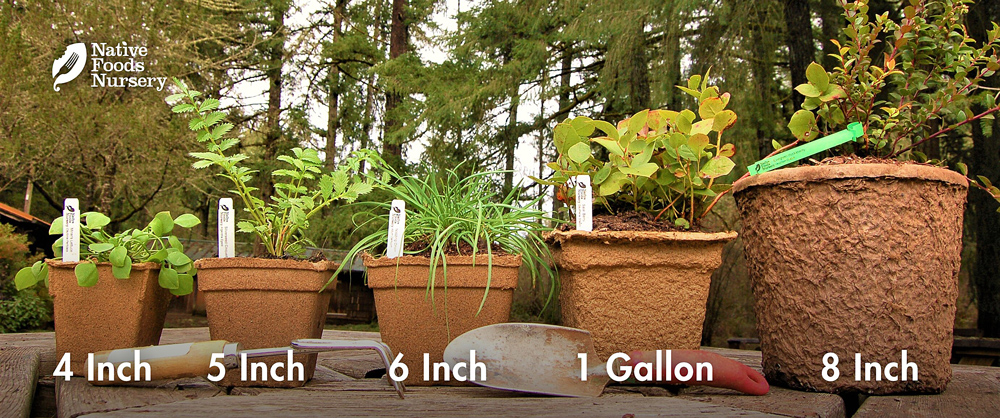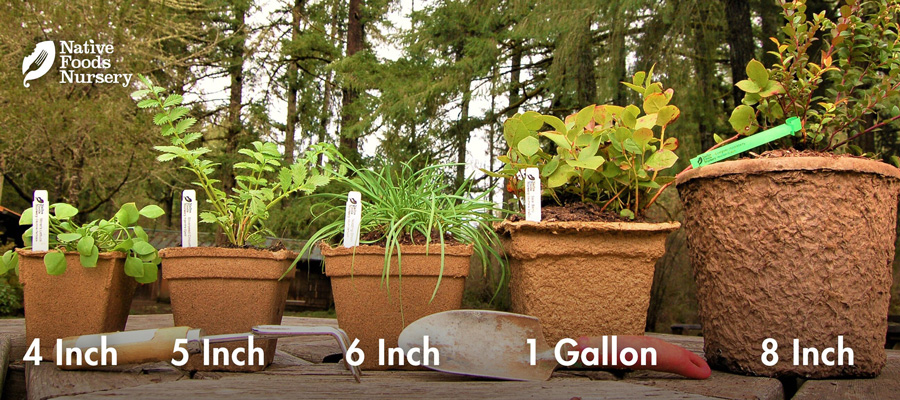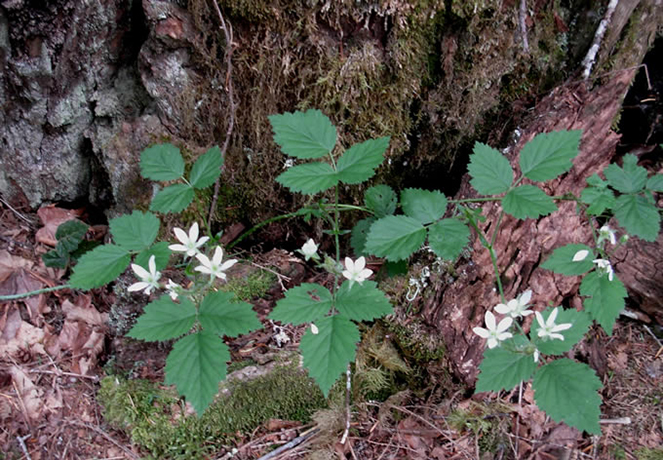Blackberry - Pacific and Black Diamond
- Current Stock:
- 0
- Other Names:
- Pacific Dewberry, california Blackberry, california Dewberry
- Latin Name:
- Rubus Ursinus
Native trailing blackberries are a signature taste of the Pacific Northwest—intensely aromatic fruit on graceful, vining canes. This page lets you choose between our thornless, high-performing ‘Black Diamond’ (a modern trailing cultivar bred from native lineage) and the wild Pacific Blackberry (Rubus ursinus), prized for flavor and habitat value. Together they cover home gardens from tidy trellises to natural hedgerows, with a long season of fresh berries and preserves. [1][3][6]
Note: 'Black Diamond' is self-fruitful while Pacific Blackberry is mostly dioecious (male and female plants on separate plants); only females fruit. We ship unsexed plants—plant 2–3 to ensure fruiting. [4] See Comparison Table at the bottom for more detail.
Edible Uses
-
‘Black Diamond’: Uniform, conical berries with excellent firmness for fresh eating, freezing, and processing; ripens around late June–July in the Willamette Valley. Flavor is good (not as intense as ‘Marion’), with reliable yields and easy picking. [2]
-
Pacific Blackberry (R. ursinus): Smaller berries, big flavor—fragrant and richly sweet-tart. Eat fresh, dry, or cook into jams, syrups, and pies. Traditional foods include dried cakes and beverages; young shoots can be eaten raw or steamed; leaves are used for medicinal teas. Blackberry fruit is naturally rich in anthocyanins and other phenolics with notable antioxidant capacity. [5][7][8]
Ornamental Qualities
White, lightly fragrant spring flowers lead to ruby-to-black fruit against lush summer foliage. Train ‘Black Diamond’ on a simple two-wire trellis for a neat, productive row; let R. ursinus trail and weave as a wildlife-friendly understory or living edge. Trellis on or alongside other native shrubs like Red Flowering Currant and Evergreen Huckleberry for a multi-season native edible border. [3][5]
Environment and Culture
-
Heritage & breeding: Trailing blackberry cultivars (including ‘Black Diamond’) draw heavily on native R. ursinus genetics; the famous ‘Marion’ is ~44% R. ursinus. ‘Black Diamond’ was released by USDA-ARS/OSU to deliver a thornless, machine-harvestable berry with Marion-type processing quality. [1][2][6]
-
Wild ecology: R. ursinus ranges from British Columbia through California and inland to Idaho/Montana; flowers support pollinators and fruit feeds birds and mammals. Indigenous communities continue to harvest and tend Pacific Blackberry as living food and medicine. [5][8] These strong and recovering peoples and plants deserve our respect, gratitude, and reparations. (Learn more & how to help on our Charitable Giving page.)
Harvest, Care, and Preparation
-
Site & soil: Full sun to part sun; well-drained, organic-rich soil. Trailing types prefer trellising. Keep even moisture for best berry size. [3]
-
Pruning: Summer-bearing trailing blackberries fruit on second-year canes (floricanes)—tie primocanes to wires in year 1; after harvest, remove spent floricanes. [3]
-
Pollination: ‘Black Diamond’ is self-fruitful; bees improve set and uniformity. Pacific Blackberry females need pollen from male plants—plant multiples. [3][4]
-
Harvest:
-
‘Black Diamond’: late June–mid July (PNW lowlands); season often a few days ahead of ‘Marion’. Firm fruit handles well fresh or frozen. [2]
-
R. ursinus: late summer into fall, picked singly as they blacken and detach easily. [5] Pick the young, tender shoots in early spring and steam them or add to soups like a vegetable.
-
(See Planting Guide in next tab for more info.)
Attributes
PACIFIC BLACKBERRY:
Native Range: BC to CA; inland to ID (also into northern Mexico) [5]
USDA Zones: ~6–9 (provenance dependent; trailing types are less cold-hardy than erect forms) [3]
Ease of Care: Easy once established
Deer Resistance: Moderate (protect new growth)
Light Requirements: Full sun to part shade
Soil Type: Best in well-drained, organic-rich soils; adaptable
Water Requirements: Low–moderate; summer moisture improves crops
Pollination: Mostly dioecious (male/female plants); only females fruit [4]
Bearing Age: ~2 years
Size at Maturity: Low mound 2–5 ft high; trailing canes 6–20 ft (trellis recommended) [5]
Plant Spacing: 2–4 ft (closer for hedging)
Bloom Time: Spring (region dependent) [5]
Harvest Time: Mid/late summer (varies by site) [5]
BLACK DIAMOND:
Origin/Type: USDA-ARS/OSU trailing blackberry cultivar with native R. ursinus background [1][2][6]
USDA Zones: 6–9 (PNW adapted) [3]
Ease of Care: Easy on trellis; manageable vigor [2]
Thorns: Thornless by commercial standards (minor prickles near cane base) [2]
Light: Full sun (part sun ok) [3]
Soil: Well-drained, organic-rich; avoid waterlogging [3]
Water: Even moisture for best size/yield [3]
Pollination: Self-fruitful [3]
Bearing Age: ~1–2 years from planting [3]
Cane Length / Height on Trellis: Canes to 10–20 ft; ~6 ft trained height [3]
Plant Spacing: 3–5 ft in row; 10 ft between rows [3]
Bloom/Harvest (PNW): Bloom spring; harvest late June–July [2]
Comparison Table
| Attribute | ‘Black Diamond’ | Pacific Blackberry (Rubus ursinus) |
|---|---|---|
| Type & Heritage | Thornless trailing cultivar bred by USDA-ARS/OSU; Marion-type quality with native R. ursinus ancestry[1][2][6] | Wild native trailing blackberry of the PNW[5] |
| Thorns / Plant Sex | Thornless by commercial standards (minor prickles low on primocanes)[2]; self-fruitful[3] | Prickly canes; mostly dioecious—only females fruit[4] |
| Ripening (PNW lowlands) | Late June–early/mid July; begins ~4–5 days ahead of ‘Marion’[2] | Summer into early fall, pick singly as they blacken[5] |
| Fruit & Use | Uniform, firm, conical; great fresh, frozen, processed[2] | Smaller but intensely flavored; fresh, dried, preserves; traditional foods and beverages[5][8] |
| Yield & Handling | High and consistent; firm fruit handles well[2] | Variable; excellent flavor, lower total yield than cultivated types |
| Trellis & Spacing | Two-wire trellis; space plants 3–5 ft in row (10 ft between rows)[3] | Trellis recommended; 3–5 ft in row (10 ft between rows)[3] |
| Nutrition | Blackberry fruit is naturally rich in anthocyanins and phenolics with notable antioxidant capacity[7] | |
References
[1] OSU Extension — Blackberry Cultivars for Oregon (trailing background from R. ursinus).
[2] USDA-ARS/OSU — ‘Black Diamond’ release (ripening, firmness, yield; thornless description).
[3] OSU Extension — Growing Blackberries in Your Home Garden (self-fruitful; spacing; training).
[4] Flora of North America — Rubus ursinus (dioecy; morphology).
[5] USFS Fire Effects Information System — Rubus ursinus (distribution; ecology; season).
[6] Oregon Encyclopedia — “Marionberry” (pedigree ≈44% R. ursinus).
[7] Siriwoharn et al., 2004 — Blackberry anthocyanins/phenolics; antioxidant metrics.
[8] Washington Native Plant Society — Rubus ursinus (ethnobotany, uses).
Pot Sizing Guide

Planting Guide: Blackberry — ‘Black Diamond’ & Pacific Blackberry (Rubus)
Tip: Think “two-wire trellis + woodland edge.” Give full sun, well-drained organic soil, and steady summer moisture for plump berries. Train canes on wires for easy picking; mulch yearly to keep roots cool and weeds down.
Choosing a Site
Light: Full sun to light shade (best yields with 6–8+ hours of sun).
Soil: Well-drained loam or sandy loam enriched with compost; avoid waterlogging. Slightly acidic to neutral soils are ideal.
Space:
‘Black Diamond’: 3–5 ft between plants on a trellis; ~8–10 ft between rows.
Pacific Blackberry: 2–4 ft for a naturalized edge or trained row; give room for trailing canes.
Planting Steps
Timing: Plant in early spring as soil becomes workable, or in fall where winters are mild.
Prepare: Dig a wide hole; blend native soil with composted bark/leaf mold for drainage and moisture retention.
Set: Place at the same depth as in the pot; spread roots, backfill, and water deeply to settle.
Mulch: 2–3 inches of wood chips or leaves (keep mulch a few inches off the crowns).
Watering & Care
Establishment (years 0–2): Keep soil evenly moist—especially during bloom and fruit fill.
After establishment: Moderate water needs; consistent summer moisture improves berry size, firmness, and flavor.
Feeding: Top-dress with compost each spring; avoid heavy nitrogen (excess vegetative growth can reduce fruiting).
Training & Pruning
Both are summer-bearing, trailing blackberries that fruit on second-year canes (floricanes).
- Year 1 (primocanes): Guide new canes along a two-wire trellis; tip lightly to encourage laterals.
- Year 2 (floricanes): Fruiting laterals develop; tie securely for support.
- After harvest: Remove spent floricanes to the base; keep 6–8 of the best new primocanes per plant for next season.
- ‘Black Diamond’ note: Thornless for easy handling (minor prickles can occur near cane bases).
Pollination & Bloom
‘Black Diamond’: Self-fruitful; good bee activity improves set and uniformity.
Pacific Blackberry: Mostly dioecious—only female plants fruit. Because nursery stock may be unsexed, plant 2–3 plants to improve the chance of having both sexes present.
Protection
Wildlife: Birds love ripe fruit—use lightweight netting as berries color. Deer may browse tender shoots; protect young plants as needed.
Airflow & sanitation: Space plants for airflow; remove spent canes and fallen fruit after harvest to limit disease cycles.
Weeds: Maintain a mulch ring (2–3 ft) to reduce competition and conserve moisture.
Harvest Basics
Timeline: First meaningful crops typically in the second year after planting.
Season (PNW lowlands):
‘Black Diamond’: Late June into July (often a few days earlier than ‘Marion’).
Pacific Blackberry: Mid-summer into early fall; berries ripen sequentially and detach easily when fully black and aromatic.
Kitchen: Chill promptly or process the same day. Both are excellent fresh, frozen, or cooked into jams, syrups, pies, and crisps.
PNW Notes
West of the Cascades, summer-dry conditions make mulch and drip irrigation valuable for steady fruit fill. In hotter interior sites, provide afternoon shade if fruit sunscald appears. Trailing canes benefit from winter training when flexible; avoid cracking cold-stiff canes.
References
- OSU Extension — Blackberry Cultivars for Oregon (trailing types, season, management).
- USDA-ARS / Oregon State Univ. — ‘Black Diamond’ thornless trailing blackberry release (HortScience, 2005).
- OSU Extension — Growing Blackberries in Your Home Garden (training, trellis, pruning, spacing).
- Flora of North America — Rubus ursinus (native PNW trailing blackberry; plant sex).
- USFS Fire Effects Information System — Rubus ursinus (distribution, ecology, phenology).
- Washington Native Plant Society — Rubus ursinus (garden notes, ethnobotany).
- Siriwoharn, T. et al. (2004). Blackberry anthocyanins/phenolics and antioxidant properties across cultivars.










